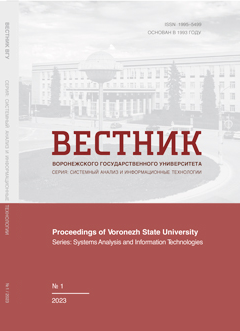Intelligent analysis system for monitoring the spread and influence of political internet memes
Аннотация
The paper explores the options for developing artificial intelligence technologies and tools aimed at enhancing the functionality of the system designed for monitoring and analyzing political Internet memes in the Russian-speaking segment of the Internet. Achieving this goal on the basis of deep machine learning methods and neural network technologies involves dealing with a number of correlated systemic interdisciplinary tasks (problems), which we discuss in the article. We introduce the architecture and functionality of the Memometrix software package, which can provide a partial solution to the problem of automatic image acquisition, tagging, filtering, grouping and exporting. Th e rationale for distinguishing different levels of macro- and micromodels, models of information interaction between intelligent agents, and control models, has been provided. Simulation modeling is helpful in adjusting the sets of algorithms to be then equipped by a search intelligent agent designed for monitoring and collecting Internet memes, and their analysis, as part of a multi-agent system for controlling the flow of Internet memes. Creating an intelligent system for monitoring Internet memes, its tuning and verification to real processes require the use of tagged databases. Building Internet meme databases involves accumulating and classifying Internet meme images, identifying their duplicates. It is required to use fi ltering, grouping and exporting the data relevant to Internet memes. Searching for memes involves making search queries and an option to perform a reverse image search, in that allowing to use the already existing databases for classifying meme images. We provide a detailed description of the package’s relevant modules, as well as an example of an interface for filtering Internet memes based on using the templates agreed upon with sociologists. The software product was developed with the use of modular architecture and comprises several applications: a Web application (user interface), a server application (provides the operation of the package), and an application for automatically collecting Internet memes. The modularity of the package allows for making adjustments in the application (analysis of collected results, visualization of collected information, prediction of the further spread of Internet memes).
Скачивания
Литература
2. Gubanov D. A., Novikov D. A. and Chkhartishvili A. G. (2010) Social networks: models of information influence, management and confrontation. Moscow : Fizmatlit. 244 p. (In Russian)
3. Breer V. V., Novikov D. A. and Rogatkin A. D. (2016) Micro- and macromodels of social networks. I. Theory fundamentals. Automation and Remote Control. 77:2. P. 313–320.
4. Batov A. V., Breer V. V., Novikov D. A. and Rogatkin A. D. (2016) Macro- and micromodels of social networks. Part 2. Identification and imitational experiments. Automation and Remote Control. 77:2. P. 321–331.
5. Breer V. V., Novikov D. A. and Rogatkin A. D. (2016) Stochastic models of mob control. Autom. Remote Control. 77:5. P. 895–913.
6. Granovetter M. (1978) Th reshold Models of Collective Behavior. The American Journal of Sociology. Vol. 83, No 6. P. 1420–1443. DOI
7. Kempe D., Kleinberg J. and Tardos E. (2003) Maximizing the Spread of Influence through a Social Network. Proceedings of the ACM SIGKDD International Conference on Knowledge Discovery and Data Mining. P. 137–146. DOI
8. Olamide T. K. (2015) Classification of Internet Memes. The University of Texas at Austin. URL
9. Siong L., Zaki W. and Hussain A. (2015) Image Retrieval System for Medical Applications. IEEE Symposium on Computer Applications & Industrial Electronics (ISCAIE). P. 73–77. DOI
10. Gabrielyan O. A. [et al.] (2021) Intellectualization Of The Sociometric Data Processing Of Internet Memes Within Virtual Communication Structure. International Scientific Forum «National Interest, National Identity and National Security». The European Proceedings of Social & Behavioural Sciences. Vol. 102. P. 274–278. DOI
11. Germenchuk M. S., Kozlova M. G. and Lukyanenko V. A. (2020) Software tools and technologies for analyzing the flow of Internet memes. Taurida Journal of Computer Science and Mathematics. 3 (48). P. 37–58. (In Russian)
12. Germenchuk M. S., Kozlova M. G. and Lukyanenko V. A. (2021) Some features of design of intelligent systems for processing the internet memes flow. CEUR Workshop Proceedings. Vol. 2834. P. 148–158.
13. Germenchuk M. S., Kozlova M. G. and Lukyanenko V. A. (2021) Identification and Prediction of an Internet Meme Flow Lifecycle. CEUR Workshop Proceedings. Vol. 2914. P. 112–123.
14. Kozlova M., Lukianenko V. and Germanchuk M. (2021) Development of the Toolkit to Process the Internet Memes Meant for the Modeling, Analysis, Monitoring and Management of Social Processes. P. 189–219, Chapter 6, DOI in book “Recognition and Perception of Images, Fundamentals and Applications” Edited by Iftikhar B. Abbasov. Wiley-Scrivener. 464 p.
15. Osterroth A. (2018) Semiotics of Internet Memes. DOI
16. Zhang P., Zakharov V. (2020) Computerized Visualization of the Russian Language Picture of the World. International Journal of Open Information Technologies. Vol. 8, No. 1. P. 58–62. DOI
17. Tian Z., Huang W. and Tong H. (2016) Detecting Text in Natural Image with Connectionist Text Proposal Network. LNCS. Vol. 9912. P. 56–72. DOI
- Авторы сохраняют за собой авторские права и предоставляют журналу право первой публикации работы, которая по истечении 6 месяцев после публикации автоматически лицензируется на условиях Creative Commons Attribution License , которая позволяет другим распространять данную работу с обязательным сохранением ссылок на авторов оригинальной работы и оригинальную публикацию в этом журнале.
- Авторы имеют право размещать их работу в сети Интернет (например в институтском хранилище или персональном сайте) до и во время процесса рассмотрения ее данным журналом, так как это может привести к продуктивному обсуждению и большему количеству ссылок на данную работу (См. The Effect of Open Access).



















